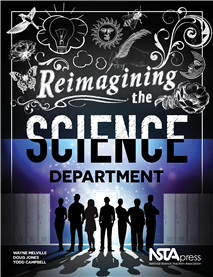Learn How to Reimagine Your Science Department
By Carole Hayward
Posted on 2015-04-16
 In NSTA Press’ new book, Reimagining the Science Department, authors Wayne Melville, Doug Jones, and Todd Campbell pose some atypical questions:
In NSTA Press’ new book, Reimagining the Science Department, authors Wayne Melville, Doug Jones, and Todd Campbell pose some atypical questions:
“Departments are a ubiquitous feature of secondary schools; but where did they come from, what purposes do they serve, and what is the traditional role of the chair?”
The authors explain that it is necessary to ask these questions if you want to understand the importance of both the department and the chair in the teaching and learning of science. By knowing how the features in contemporary departments have evolved, you can begin to appreciate the power of departments in perpetuating a particular view of science education. If you understand this history, then as a chair (or aspiring chair), you will have a knowledge base from which to work in reforming science instruction in your department.
Departments are not just convenient administrative structures within secondary schools, although that is often how they appear. Contemporary science departments are simultaneously learning communities, which powerfully influence what and how teachers teach and administrative organizations within secondary schools. A chair that sees the department as both organization and community is in the best position to judge the most appropriate approach to the issues being faced.
Implementing and supporting the teaching and learning rooted in engaging students in science and engineering practices to use disciplinary core ideas and crosscutting concepts to explain phenomena or solve problems outlined in the NGSS will require changes in teachers’ professional learning—changes that are intimately linked to the roles and responsibilities of the department chair.
To encourage teachers to take greater ownership of the reforms will, to a large extent, depend on your leadership capabilities. These capabilities, and increasingly those of individual teachers, will impact and ultimately shape what the department looks like in the future.
Departments do not, however, work in isolation from the rest of the school. To reimagine the department is to also be active in developing strong political and practical relationships with school administrators. Without their support, change is difficult to initiate and even more difficult to sustain. The aim of reimagining the department is to develop a long-term culture that is simultaneously owned by the teachers and supported by school administrators.
Building trust within the department is paramount. Faith in your colleagues and the assumptions that reimagining the department are based on emanates from trust. Leading a paradigm shift in thinking and practice of any magnitude is a challenge that requires leadership based on hope, trust, faith, and civility from both the chair and the department, supported by school administrators.
Reimagining the Science Department will help you understand the importance of the position and develop your ability to lead. School administrators or school board members will find it deepens the commitment to developing a department in which the practices of science are taught for the benefit of all students. The authors divide the book into five key sections:
- A History of the Science Department
- Changing Scripts
- Roles and Responsibilities
- Getting Started
- Building for the Long Term
This book is also available as an e-book.
The mission of NSTA is to promote excellence and innovation in science teaching and learning for all.
Follow NSTA
Disclaimer: The views expressed in this blog post are those of the author(s) and do not necessarily reflect the official position of the National Science Teaching Association (NSTA).


